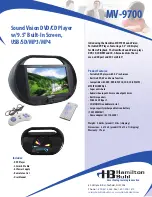
1
9
Cooling system - Coolant
Maintenance
The cooling system enables the engine to operate at an
optimal temperature.
In the case of a cooling by closed heat exchanger, the
coolant is cooled by sea water passing through the ex-
changer. Then it cooled several components of the en-
gine.
In a Keel Cooling system, engine heat is dissipated by
passing coolant through tubes incorporated to the hull.
Contact the installer of the genset for more informations.
The cooling system must be filled with a coolant com-
prising 50% water and 50% anti-freeze and anti-corro-
sion additive.
The coolant must be changed regularly as the additives
become less effective over time. Prepare the mix be-
fore filling the exchanger. If the generating set must be
switched off for a long period in an environment with a
high risk of frost, the coolant must be drained.
I
Attention! :
Never use just water to fill the cooling
circuit. Always use a clean receptacle and ensure the
fluids are well mixed.
Draining and rinsing the cooling circuit
The coolant in the cooling circuit must be drained in or-
der to remove the various deposits that can build up in
the circuit.
Carry out this operation with the engine stopped and
cold.
• Place a receptacle under the drain cap then un-
tighten it.
• Let the coolant run out until the exchanger is empty.
• Open the coolant fill cap and clean the inside of the
heat exchanger with clean water and a hose.
• Continue until clean water runs from the drain ori-
fice.
• Once the water has been totally removed from the
exchanger, close the unit drain cap again then refill
with coolant.
Coolant filling
I
Attention! :
Do not check the coolant level when
the engine is hot. Pressurised coolant can spurt and
cause serious burns. Carry out this work with the
engine stopped and cold. Only use new coolant when
replenishing or adding coolant.
The coolant level must be between the min and max
level indicated in the exchanger.
• Turn the fill cap
A
situated on the heat exchanger
to its first stop to release the system pressure and
then remove the cap.
• Fill the heat exchanger slowly with coolant up to the
maximum level in order to let the air escape.
• Run the engine for several minutes and keep it
idling. Stop the engine, wait a few moments, then
check the coolant level again. Fill again if neces-
sary.
A








































